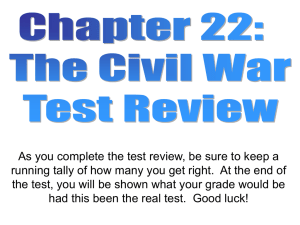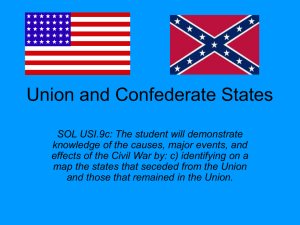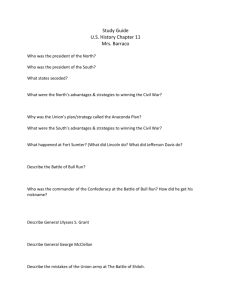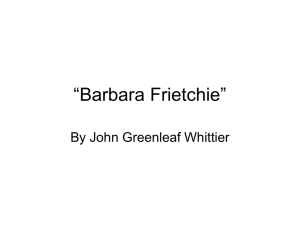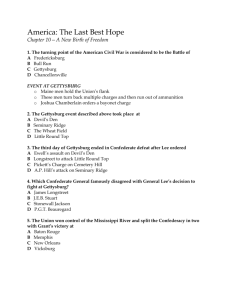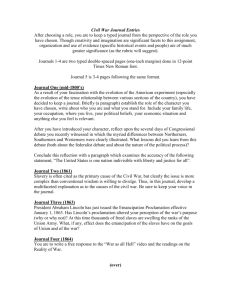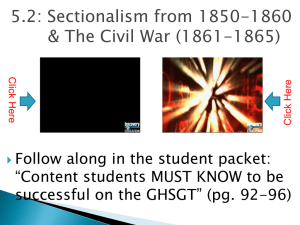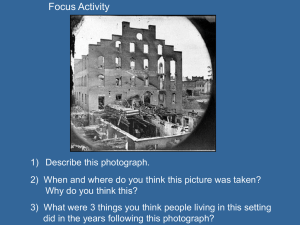The Civil War - NC-NET
advertisement
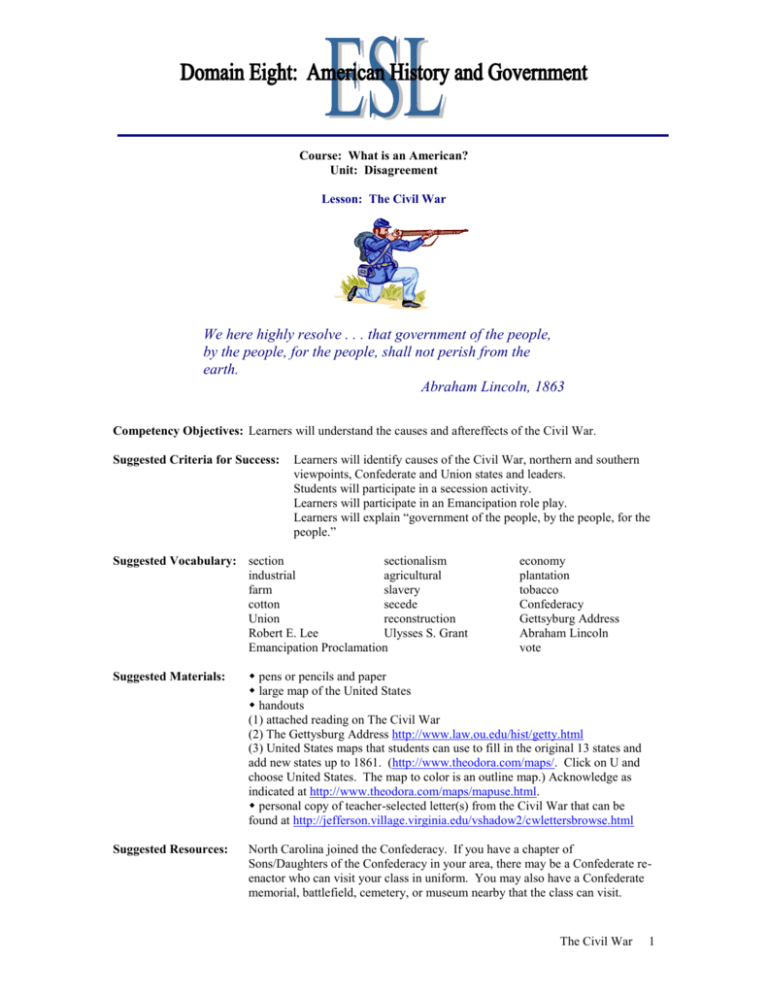
Course: What is an American? Unit: Disagreement Lesson: The Civil War We here highly resolve . . . that government of the people, by the people, for the people, shall not perish from the earth. Abraham Lincoln, 1863 Competency Objectives: Learners will understand the causes and aftereffects of the Civil War. Suggested Criteria for Success: Learners will identify causes of the Civil War, northern and southern viewpoints, Confederate and Union states and leaders. Students will participate in a secession activity. Learners will participate in an Emancipation role play. Learners will explain “government of the people, by the people, for the people.” Suggested Vocabulary: section sectionalism industrial agricultural farm slavery cotton secede Union reconstruction Robert E. Lee Ulysses S. Grant Emancipation Proclamation economy plantation tobacco Confederacy Gettsyburg Address Abraham Lincoln vote Suggested Materials: pens or pencils and paper large map of the United States handouts (1) attached reading on The Civil War (2) The Gettysburg Address http://www.law.ou.edu/hist/getty.html (3) United States maps that students can use to fill in the original 13 states and add new states up to 1861. (http://www.theodora.com/maps/. Click on U and choose United States. The map to color is an outline map.) Acknowledge as indicated at http://www.theodora.com/maps/mapuse.html. personal copy of teacher-selected letter(s) from the Civil War that can be found at http://jefferson.village.virginia.edu/vshadow2/cwlettersbrowse.html Suggested Resources: North Carolina joined the Confederacy. If you have a chapter of Sons/Daughters of the Confederacy in your area, there may be a Confederate reenactor who can visit your class in uniform. You may also have a Confederate memorial, battlefield, cemetery, or museum nearby that the class can visit. The Civil War 1 http://uscis.gov/graphics/ Click on Immigration Services and Benefits (left side of page). Then click on Naturalization (left side of page). Now click on Eligibility and Testing. From this location scroll down and Click on Download United States History Study Guide for Civics Exam. (107 pages) Click on Download United States Government Structure Study Guide For Civics Exam. (58 pages) Click on 100 Sample US History and Government Questions with Answers. (9 pages) Go to http://www.eduref.org. Click on the tab that says Lesson Plans, than on Social Studies, U.S. History, Civil War, and Civil War: Emancipation Experience for a printer-friendly lesson plan by Bryan I. Yamishita. Another lesson plan, Role Playing the Civil War, is available at this same location. “In the great events of history, nothing is inevitable.” -Jay Winik. Go to http://www.historychannel.com/, and click on Classroom (across the top of the page), then on Study Guides (center screen). Scroll down and click on April 1865: The Month That Saved America for a Study Guide on the end of the Civil War. http://www.usflag.org/confederate.stars.and.bars.html Confederate Stars &Bars If you can’t access this site directly, go to http://www.usflag.org and use the search function. Enter confederate stars and bars and click on Go. You may access the addresses below directly, or you may need to go to http://www.researchonline.net and click on Research on Line, then on The Civil War in Georgia. Scroll down and click on The Civil War in Georgia again. Then click on Contents, The Confederate Flag, and within that document, The First National C.S.A. Flag or The Confederate Battle Flag. http://www.researchonline.net/gacw/conflag9.htm First Confederate flag. http://www.researchonline.net/gacw/confla12.htm Confederate Battle Flag http://www.researchonline.net/gacw/conflag1.htm Confederate flag. http://www.law.ou.edu/hist/getty.html Gettysburg Address http://www.loc.gov/exhibits/gadd/. Gettysburg Address For The Emancipation Proclamation, go to http://www.nps.gov and click on Parks and Recreation. Click on more under “View All Parks A-Z”, scroll down and choose Antietam National Battlefield. Click In Depth (right side of page). Click on Special Subjects. Click on Emancipation Proclamation near the bottom of the page. http://www.eyewitnesstohistory.com/appomatx.htm Surrender at Appomattox, 1865 http://jefferson.village.virginia.edu/vshadow2/cwlettersbrowse.html Searchable Civil War Letters. http://www.calendarzone.com/Historic Scroll down and click on Civil War Daily. Enter a day and year to see what occurred on one that day of the war. Suggested Methods: Lecture/Discussion, Map Work, Journal Work The Civil War 2 Some Suggested Steps Causes. Use the attached reading assignment The Civil War. Read the part on Sectionalism. Secession. Use the attached reading that begins with Secession. Have the students do map work. Start with building America. Review the colonies, and then review the addition of states through 1850. How many years did it take to settle the first 13 colonies? How many years did it take to add 13 more colonies? Add the three new colonies that joined the Union prior to the start of the Civil War. These are Minnesota (May 11, 1858), Oregon (February 14, 1859), and Kansas (January 29, 1861). Now ask learners to look at the secession dates in the footnote on Sectionalism and remove (blacken) the colonies that seceded. How long did it take for 13 colonies to secede? The War. Periodically your students will see representations of the Confederate Battle Flag and may run into strong feelings about it. Teach your class about the Confederate Flag, using reference materials of your choice. At http://www.usflag.org/confederate.stars.and.bars.html you will find a series of the flags used during the war, ending with the Confederate Navy Jack, now recognized in popular culture as the Confederate Flag. Use the part of the attached reading that covers the War. You may also enjoy sharing with your class selections from http://jefferson.village.virginia.edu/vshadow2/cwlettersbrowse.html. This site has searchable Civil War letters that give a picture of life during the war. For brevity and simplicity, you will need to choose paragraphs rather than whole letters, but these writings show the life of the people during the war. (Look at Letters from Augusta County, Virginia, P.H. Powers, May 4, 1864.) Emancipation Proclamation. Use the materials from http://www.eduref.org to illustrate the emancipation experience: see Suggested Resources above for directions to locate the lesson plan Civil War: Emancipation Experience by Bryan I. Yamishita. Abraham Lincoln and the Gettysburg Address. Lincoln saw the war as a fight not only to save the Union, but also to establish freedom and equality for all under the law. Distribute handouts of the Gettysburg Address. Read and discuss. What does Lincoln mean by government of the people, by the people, for the people? Write your answer in your Journal. Does this phrase still apply to government in America today? The Decisions that Saved America. “With malice toward none, with charity for all, with firmness in the right as God gives us to see the right, let us strive on to finish the work we are in; to bind up the nation’s wounds; to care for him who shall have borne the battle, and for his widow and his orphan – to do all which may achieve and cherish a just and lasting peace, among ourselves, and with all nations.” Lincoln’s Second Inaugural Address, March 4, 1865 What decisions allowed the North and the South to reunite? Did the North hang the leaders of the South? Did the South retreat and wage guerilla warfare for years to come? What is meant by “a generous peace?” Why did the North and South never go to war again? What might have been different if Lincoln had not been shot five days after Lee surrendered to Grant? How was the end of the Civil War different from many other wars in our world? Reconstruction. Do the attached reading on Reconstruction. Ask the students how they think the Southern states felt during Reconstruction. Why? Was Reconstruction a good thing? Why or why not? Journal Work. Abraham Lincoln had a difficult job as President. Do you know who the President is today? Think about what it would be like to be president. Choose one of the two activities on the next page and write in your Journal: The Civil War 3 1) If I were President I would - - -. You may write from a present-day or an historical point in time. 2) Write a letter to the President. You may write to the current President or to Abraham Lincoln. The Civil War 4 The Civil War Sectionalism. People were loyal to the section of the United States where they lived. The economy of each section was different. The North was industrial, with banking, shipping, manufacturing. The South was agricultural, with large plantations. The West was agricultural, with small independent farmers. Economic differences led the sections of the country to disagree about many things. These differences eventually led to the Civil War. The plantation economy of the South used slaves to grow tobacco and cotton. In 1860 one of every seven Americans was a slave. Northern states did not allow slavery. Slavery was the most emotional of the economic issues in the war. The North and South had different ideas about the Union of American states. The North had more political power and made laws that hurt the agricultural South. The North believed the South had to obey the laws of the Union. The South believed it had joined the Union and it could secede from (leave) the Union. Another problem for the South was the election of Abraham Lincoln as President of the United States. Lincoln was a northerner who opposed slavery. The Civil War 5 Check your reading. Tell which section of the country (North, South, or West) _____ grew cotton and tobacco _____ had the most political power _____ had independent farmers _____ wanted to preserve the Union _____ seceded from the Union _____ used slaves _____ had factories _____ seceded from the Union _____ did not allow slavery _____ was the newest part of the country Who was elected President of the United States just before the Civil War? a. George Washington b. Abraham Lincoln c. Patrick Henry d Ulysses S. Grant The Civil War 6 Secession. South Carolina seceded from the Union four days after Lincoln was elected. Mississippi, Florida, Alabama, Georgia, Louisiana, and Texas followed. This group of states formed the Confederate States of America with Jefferson Davis as President. They were joined by Virginia, Arkansas, North Carolina, and Tennessee, for a total of 13 Confederate States. The War. The first shot of the Civil War was fired at Fort Sumpter, South Carolina. The war was fought from 1861 – 1864. The Northern states were called the Union. The Southern states were the Confederacy. There were great leaders on both sides. Robert E. Lee led the grey-clad Rebels of the South. Ulysses S. Grant led the North. The North had more men and supplies (the industry to build weapons, the railroads to transport troops and supplies, most of the nation’s financial resources, and control of the Navy). Gettysburg Address. In 1863 the North won a bloody victory at Gettysburg, Pennsylvania. President Lincoln dedicated the battlefield as a cemetery for those who died there. In the Gettsyburg Address, he called America “a nation conceived in liberty and dedicated to the proposition that all men are created equal.” He asked the living to honor the cause of those who fought and give the nation “a new birth of freedom so that government of the people, by the people, for the people should not perish from the earth.” *South Carolina (December 20, 1860), Mississippi(January 9, 1861), Florida (January 10,1861), Alabama (January 11, 1861), Georgia (January19, 1861), Louisiana (January 26, 1861), Texas (February 1, 1861), Virginia (April 17, 1861) , Arkansas (May 6, 1861), North Carolina (May 20, 1861), and Tennessee (June 8, 1861). The Civil War 7 Check your reading. Tell which section of the country (North or South) _____ Union _____ Robert E. Lee _____ was where the first shot was fired _____ Ulysses S. Grant _____ wore blue uniforms _____ lost the war _____ had more men and supplies _____ Confederacy _____ won the war _____ wore grey uniforms Find six states that seceded from the union. _____ Massachusetts _____ Virginia _____ Texas _____ Mississippi _____ South Carolina _____ Pennsylvania _____ North Carolina _____ Maryland _____ Georgia The Civil War 8 Emancipation Proclamation. President Lincoln issued the Emancipation Proclamation, effective January, 1863, to free the slaves in all the Confederate states. After the war ended, the 13th Amendment was added to the Constitution to prohibit slavery. Surrender. The North won the war in 1865 when General Lee surrendered to General Grant at Appomattox, Virginia. Reconstruction. Five days after the war ended, Lincoln was at the theater when he was shot and killed by an actor named John Wilkes Booth. Vice-President Andrew Johnson became President. Congress established five military districts in the South, each led by a Union general. The 13th, 14th, and 15th Amendments were added to the Constitution to help the blacks live as free men. The 14th Amendment made all blacks citizens. The 15th Amendment gave blacks the right to vote. Reconstruction finally ended in 1877. The Civil War 9 Check your reading. Match the following correctly. _____ 13th Amendment a. Ulysses S. Grant _____ 14th Amendment b. freed slaves in the Confederate states _____ 15th Amendment _____ Reconstruction c. reunited the South with the Union under military rule d. prohibited slavery _____ Emancipation Proclamation e. made blacks citizens _____ Northern General f. Robert E. Lee _____ Southern General g. gave blacks the right to vote Put a check mark beside the correct answer President Lincoln was killed in a theater died in the Civil War died of natural causes The South Surrendered at Appomattox, Virginia at Gettysburg, Pennsylvania at Fort Sumpter, South Carolina The Civil War 10
